When you see a Taiwan Bee Shrimp for the first time it’s hard not to be charmed by their unique qualities. The little shrimp are small to the point of being a true nano-sized aquarium pet. Yet they are also brilliantly colored and active out in the open.
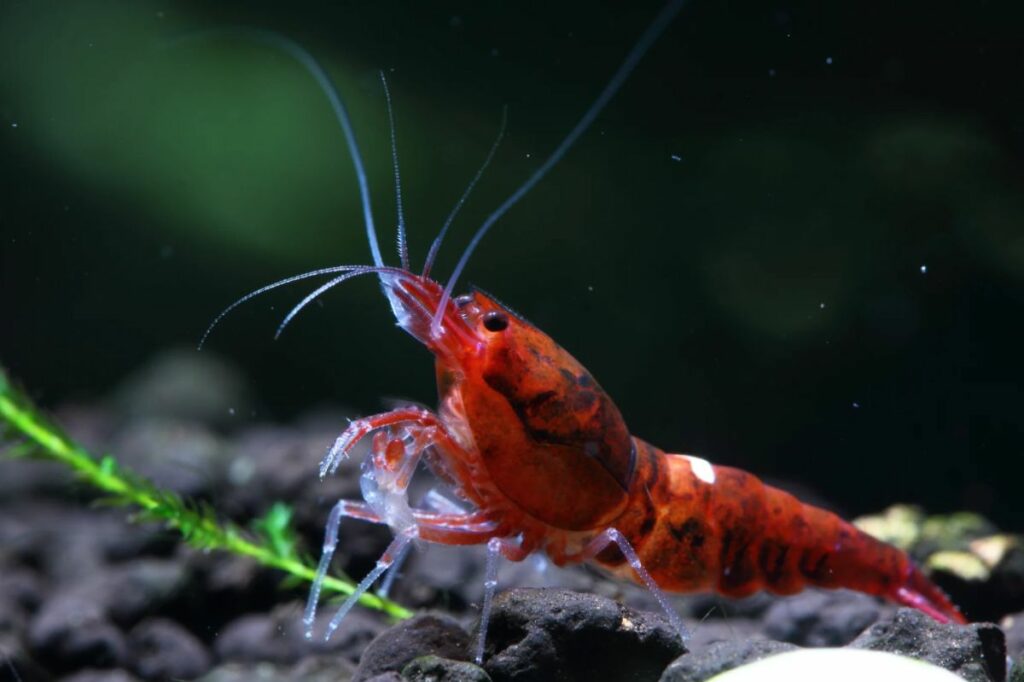
Most freshwater fish keepers are familiar with the common Ghost Shrimp. The Red Cherry Shrimp is also hardy, popular, and comes in plenty of color varieties. But Bee Shrimp are often considered a step up from the Ghost and Cherry Shrimp. So let’s take a closer look at this intriguing freshwater invertebrate together.
What is the Taiwan Bee Shrimp?
Bee shrimp are native to Taiwan but have been introduced to Southeastern China and Vietnam. These escapees from the pet trade now live as wild populations on the Asian mainland.
On their Taiwanese home island Bee Shrimp are found in mountain streams with cool water and specific water chemistry. Wild Bee Shrimp are not too sensitive. But the color varieties developed over the years in Japan, China, and Taiwan are all inbred across several generations. This fixes these beautiful hues into stable varieties like Crystal Red and Golden Bee Shrimp.
But it also weakens each generation and makes these inbred shrimp more sensitive to changes in water conditions and diseases. That’s why captive bred Bee Shrimp are moderately difficult to care for.
That said, raising Bumble Bee Shrimp is similar to reef keeping and other, more difficult, aquarium projects. Successfully maintaining – or even breeding – these dwarf freshwater shrimp is a major achievement.
- Common Names: Taiwan Bee Shrimp
- Scientific Name: Caridina cantonensis
- Origin: Taiwan & China
- Length: Up to 1 inch
- Aquarium Size: 5+ Gallons
- Temperament: Peaceful; Shy
- Ease of Care: Moderate
Types of Bumble Bee Shrimp
The most common types of Bee Shrimp found in pet stores are the following:
- Crystal Red Shrimp
- Bumble Bee Shrimp
- Orange Bee Shrimp
- Calceo Bee Shrimp
- Golden Bee Shrimp
Crystal Red Bee Shrimp are the most popular. They have brilliant red stripes against a white background. This color variety would never be found in the wild since predators will spot them right away.
But in an aquarium they look impressive against a dark substrate and the greens of aquatic plants. There are also Crystal Black Shrimp, which exchange the red for bold black stripes.
It is thought that the Crystal Red shrimp is descended from just 3 original specimens. So even for Bee Shrimp they are sensitive and tricky to care for.
Wild Bee Shrimp have a mixture of brown and black blotches against a clear body. These patterns help them blend in with plants and river stones. Shrimp are prey animals so they need to avoid the notice of predators like fish and birds.
Setting Up a Bee Shrimp Tank
Bee Shrimp live up to their name not just in color but also in terms of size. Adult Bee Shrimp size is at maximum one inch. And often they stay even smaller – 2 centimeters is average for these crustaceans.
Bee Shrimp lifespans are average for shrimp but short compared to fish and other aquatic pets. 14 to 18 months is typical for a Bee Shrimp, from hatching to old age.
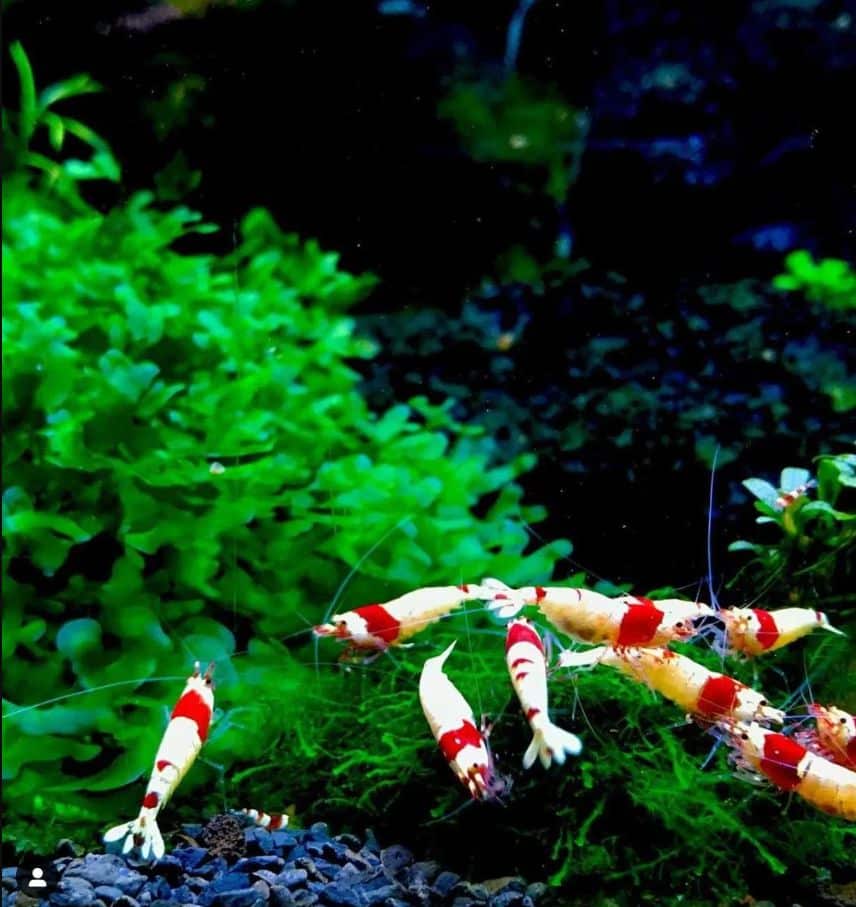
Bee Shrimp Aquarium Size
It is true that Bee shrimp are so small that they can live their entire lives with comfort and company in a small 5 gallon aquarium. Even a 2 gallon nano tank will be a great home for a small shrimp colony.
But if this is your first time keeping a shrimp bee I recommend upgrading to a 10 gallon aquarium. These shrimp are very sensitive to poor water conditions and chemistry. So you want a bit more water volume to buffer any problems that might arise.
If a bit of leftover food decays into ammonia it will poison a small 2 gallon tank faster than a larger 10 gallon one. Smaller tanks will also become hotter or colder in a short amount of time, which can stress or kill Bee Shrimp.
Water Conditions for Bee Shrimp
Bee Shrimp should never be added to an uncycled aquarium. Your beneficial bacteria should already be well established and processing ammonia, nitrite, and nitrate. All shrimp are very sensitive to these three compounds. Amounts that fish wouldn’t notice will stress or even kill Bee Shrimp.
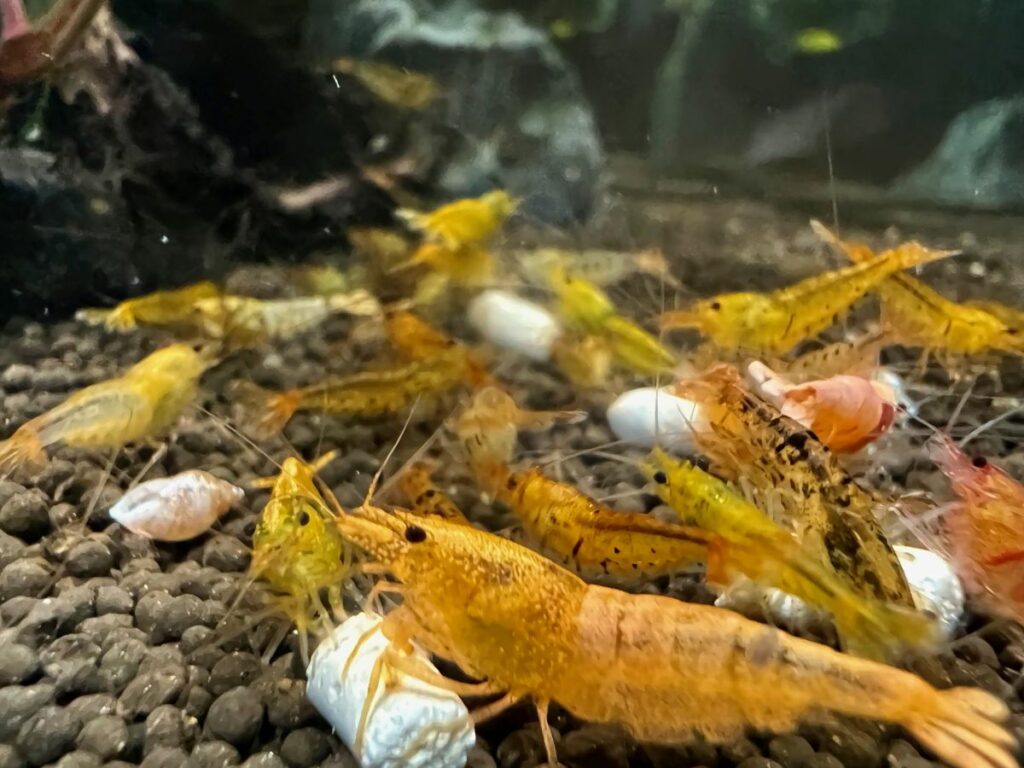
Crystal Red and Black Bee Shrimp also need water that is slightly soft to neutral in chemistry (pH 6.0-7.0). Slight alkalinity is tolerated but the closer you can get to their preferred range the better their health will be.
Shrimp keepers use distilled or reverse osmosis (R.O.) water for water changes. This way you can control the chemistry and include just the right additives and salts to keep your shrimp healthy. Tap water has all sorts of minerals that prevent proper pH and hardness control.
Water hardness is also important to them. The carbonate hardness (KH) should be between 0 and 2 DKH. Which tap water almost never achieves. Another reason to use distilled and R.O. water for shrimp tanks (already at 0 DKH)
Bee Shrimp water temperature should remain between 65-74°F. Aquarists report success with cooler or warmer conditions but this is their preferred range. In some parts of the world you won’t need a heater as long as the ambient room temperature does not swing much.
What Do Bee Shrimp Eat?
Feeding Bee Shrimp is one of the most enjoyable parts of the hobby. These tiny crustaceans are detritivores and vegetarians. Bee Shrimp pick through the bottom looking for algae, biofilm, micro organisms, and other organic matter.
In a mature planted aquarium there is often plenty of growing film to keep a small colony of Red Bee Shrimp fed. But in a newer aquarium you will have to supplement their diet with prepared
food blends.
Modern shrimp food comes in pellets that soak and fall apart. Or as a powder that falls into the water column. These powders contain a mixture of minerals, bacteria, algae, plant, and animal matter. All of this nutritional diversity is important for proper shell growth, molting, and breeding.
Blue Bee Shrimp Tank Mates
You need to be very careful when choosing Bee Shrimp tank mates. All shrimp are the natural prey of aquatic animals. Even peaceful fish like Tetra fish will nip at a weakened or baby shrimp.
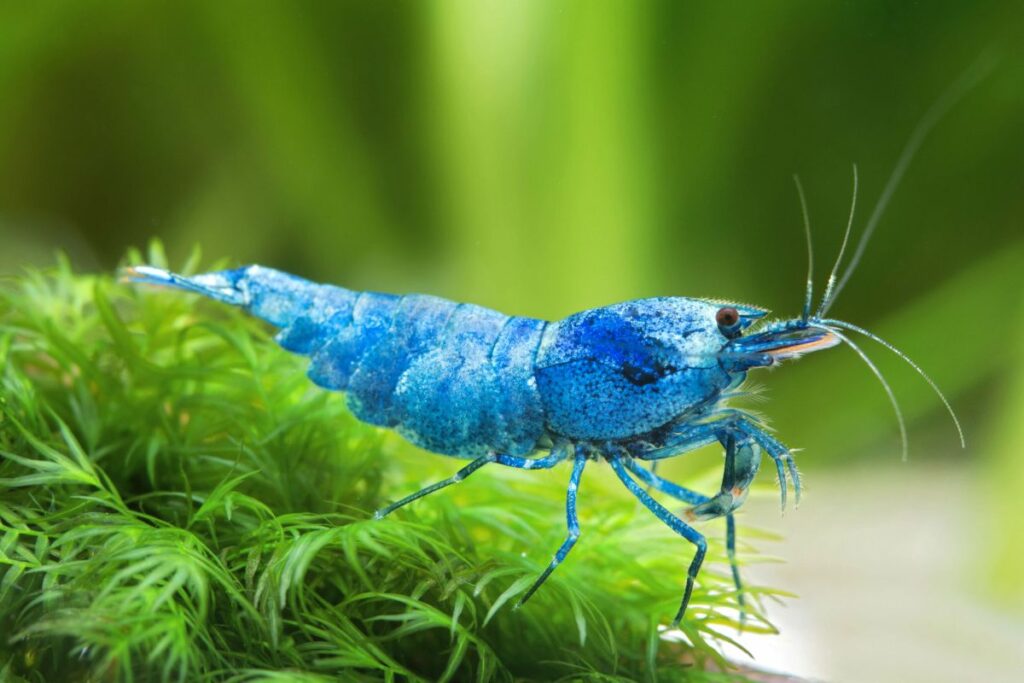
The best Bee Shrimp tank mates are small aquarium fish that are similar in size or just a little larger. Chili Rasboras and Neon Tetras are popular options since they are the same length as an adult Bee Shrimp. Bettas grow too large and will try to eat baby shrimp. But Sparkling Gouramis are a good choice.
Guppies, White Cloud Minnows, Celestial Pearl Danios, and Endler’s Livebearer are also the right size and temperament. Just make sure that any nano fish you choose also does well in the cooler water conditions that Bee Shrimp need.
Other small freshwater shrimp like Amano Shrimp and Red Cherry Shrimp will also work as long as they are peaceful. Large clawed freshwater prawns and Crayfish are too predatory and will eat any Bee Shrimp in the tank.
Bee Shrimp Breeding
If you have mastered caring for these little crustaceans then breeding Taiwan Bee Shrimp will happen by itself.
Female Bee Shrimp are larger, have brighter colors, and a curved underbelly. This curvature provides space for the female to carry her mass of eggs under her tail. These sexual traits are visibly at around 4 to 5 months of age.
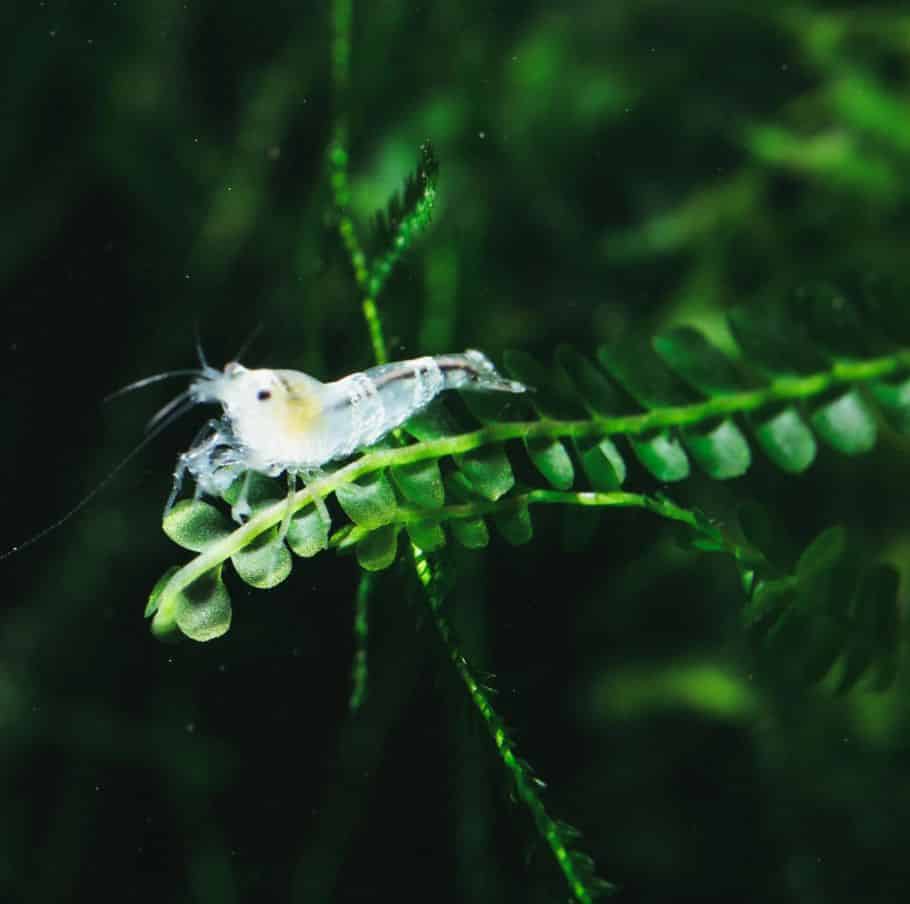
Similar to Red Cherry Shrimp, Caridina Bee Shrimp are “higher order shrimp.” This means that when their eggs hatch the babies look like miniature adults. Ghost Shrimp are “lower order shrimp.” Their eggs hatch into planktonic larvae that take weeks to look like small shrimplets.
Since Bumble Bee tiny shrimp larvae are already mobile they need next to no additional care. The shrimplets eat the same food as the adults do. Though if there is not much biofilm in the aquarium adding some powdered shrimp food will help them grow.
Survival rates may not be all that high. This is very true of Crystal Red Shrimp, which have fragile genetics. But a few will always survive to adulthood, ensuring your enjoyment of Bee Shrimp continues for years to come.
Conclusion
Red and Orange Bee Shrimp care is a little more complicated than caring for other species of shrimp. But if you can maintain the water conditions they need they are a unique pet that need little food or space. Even a small desktop aquarium with a few plants and shrimp will provide hours of enjoyment per day.
More Frequently Asked Questions about Bee Shrimp Care
Taiwan Bee Shrimp are a little more difficult than other freshwater invertebrates. Since I get several questions about Bumble Bee Shrimp care I thought I’d address a few of them here.
Taiwan Bee Shrimp are considered moderate in care. They have precise water quality needs in terms of chemistry and temperature. Bee Shrimp also need a diverse diet including both plant and animal matter. But if you can provide these conditions they are quite hardy and will soon breed.
Orange Bee Shrimp will live alongside Red Cherry Shrimp just fine. Both shrimp species are similar in size and eat the same foods. They are also not close relatives so they won’t hybridize. You can also keep Amano Shrimp alongside Bee Shrimp. Just remember that the Amano Shrimp are much larger and will consume algae and biofilm faster than the Bee Shrimp.
Just the smallest aquarium fish species will live in peace with Bee Shrimp. Shrimp are a natural prey item for fish. So any tank mate should be around the same size. Smaller danios, rasboras, tetras, gouramis, and livebearers are all good Bee Shrimp tank mates.

